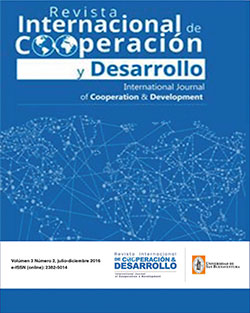INTERNATIONAL JOURNAL OF COOPERATION AND DEVELOPMENT
Assignment of Rights
Authorization for reproduction, publication, communication and distribution of a literary, artistic or scientific
Work.
I , ____________________________________________, author of the book and / or article , of legal age , resident of the city of _________________ , identified with citizenship / passport n° ______________________ issued on _______________________, in exercise of his physical and mental faculties , part henceforth be called the AUTHOR , supports the following authorization to the reproduction, publication, communication and distribution of a work, perform the following terms:
1. Regardless of current legal regulations due to the linking of the parties to this contract, and any kind of legal presumption , the parties agree that the AUTHOR authorize ( name of the publisher ) to reproduce , publish , communicate and distribute the material referred to in the International Journal of Cooperation and Development of the University of San Buenaventura.
2. Such authorization lies in particular on the copyright of the work, by any means known or unknown, publication of the work, distribution of the work , either directly or through third parties for purely educational purposes.
3. AUTHOR agrees to report and declare the existence of this authorization and to preserve the right of the International Journal of Cooperation and Development of the first publication of the work.
4. AUTHOR declares that the article is original and that it is his sole creation, no impediment of any kind exist for the authorization he is doing, besides being responsible for any action claim, plagiarism or other type of claim that might arise about .
5. Such permission is free of charge.
6. Moral copyright in the article are solely the AUTHOR and the University of San Buenaventura expressly agrees to recognize and respect them rigorously.
The Author and / or AUTHORS
SIGNATURE
Abstract
First of all, this article aims to bring up some considerations about the post-conflict as goal of the political and economic activity in Colombia, understanding the challenges that the country must face now when it is immersed in a time of Post-Agreement; which means an important contribution to the future of the country. This will be possible taking a look towards countries which are under construction of peace and going through a period of post-conflict; It will allow , in second
instance, advise about mistakes that could be committed, and at the same time, it will work to indicate directions towards which should be focus the attention and the aid for those who have been the protagonists of the conflict (victims and perpetrators) once the Government of Colombia and the Revolutionary Armed Forces of Colombia-Popular Army (Spanish inicial FARC-EP) reached an agreement to end it.
Keywords:
References
Lyne Rienner Publishing: Ottawa. Castellani, F., Parent G., y Zenteno, J, (2014). The Latin American middle class fragile after all?
Working paper 557, BID, Washington, D.C.
Celis, A. (1999). Las minas anti-personal. Posibilidad en medio del conflicto. Panorama general de las minas anti-personal en Colombia.
Bogotá, p. 5.
Construir la paz a través del desarrollo. Recuperado
de http://www.bancomundial.org/temas/resenas/post-conflicto.htm
Cronología del proceso de paz entre el Gobierno y las Farc. (26 de septiembre de 2016).Recuperado de http://www.vanguardia.com/colombia/374365-cronologia-del-procesode-paz-entre-el-gobierno-y-las-farc
Development Action Committee (DAC). 1997 Guidelines on Conflict, Peace, and Development Cooperation. Organización para la cooperación y el Desarrollo Económico: Paris .
Doyle, M y Sambanis N. (2000). International Peacebuilding: A Theoretical and Quantitative Analysis. American Political Science Review,94(4),
Echeverry, J. (2002) Las Claves del futuro: Economía y conflicto en Colombia. Editorial Oveja Negra: Bogotá.
El tejido social. Recuperado de http://www.habitatmexico.org/el-tejido-social/
El Panorama Actual de Colombia: Ley de Víctimas y Restitución de Tierras Ley 1448. Recuperado de http://www.abcolombia.org.uk/
downloads/Colombia_the_Current_Panorama_Spanish.pdf
Forman S. y Stewart P. (2000). Good Intentions: Pledges of Aid for Postconflict Recovery. Lynne Rienner Publishers.
García Duran, M. (2010). Colombia: Conflicto Armado, Procesos de negociación y retos para la paz. En V. Alejo, Colombia: Escenarios Posibles de Guerra o Paz (pág. 265). Bogota:Universidad Nacional de Colombia.
Gerson, A. y Wood, E. (2001). Forging Democracy form Below: Insurgent Transitions in South Africa and El Salvador, Cambridge University Press: London.
Hampson, F (1996). Nurturing peace: Why peace Settlements Succeed or Fail. United States Institute of Peace: USA.
Herman, J (1997). Trauma and Recovery. Basics Books: New York.
International peace Academy. Policies and Practices for Regulating Resource flows to Armed Conflict, IPA Conference Report, Rockefeller
Foundation Bellagio Study and Conference Center: Bellagio, Italia, 21-23 de mayo de 2002.
Lund, M. (2002) ¿What Kind of Peace is Being Built? Taking stock of Peacebuilding and Charting Next Steps. Documento de discusión,
preparado en ocasión del décimo aniversario de la Agenda de la Paz, para el International Development Research Centre (IDRC), Ottawa, Canadá, octubre.
Luz verde. Recuperado de http://www.semana.com/nacion/articulo/corte-penal-internacional-se-declaro-satisfecha-con-el-acuerdo-final-entre-gobierno-y-farc/492263
Medina, C. (2009). FARC-EP. Notas para una historia política 1958-2008. Bogotá D.C: Universidad Nacional de Colombia.
Organización de las Naciones Unidas (ONU. An agenda for peace: Preventive diplomacy, Peacemaking and Peacekeeping. Report of
the Secretary general, United Nations GA and SC, A/47/277, S/24111, 17 june 1992. Recuperado de www.un.org/Docs/SG/
agpeace.html














